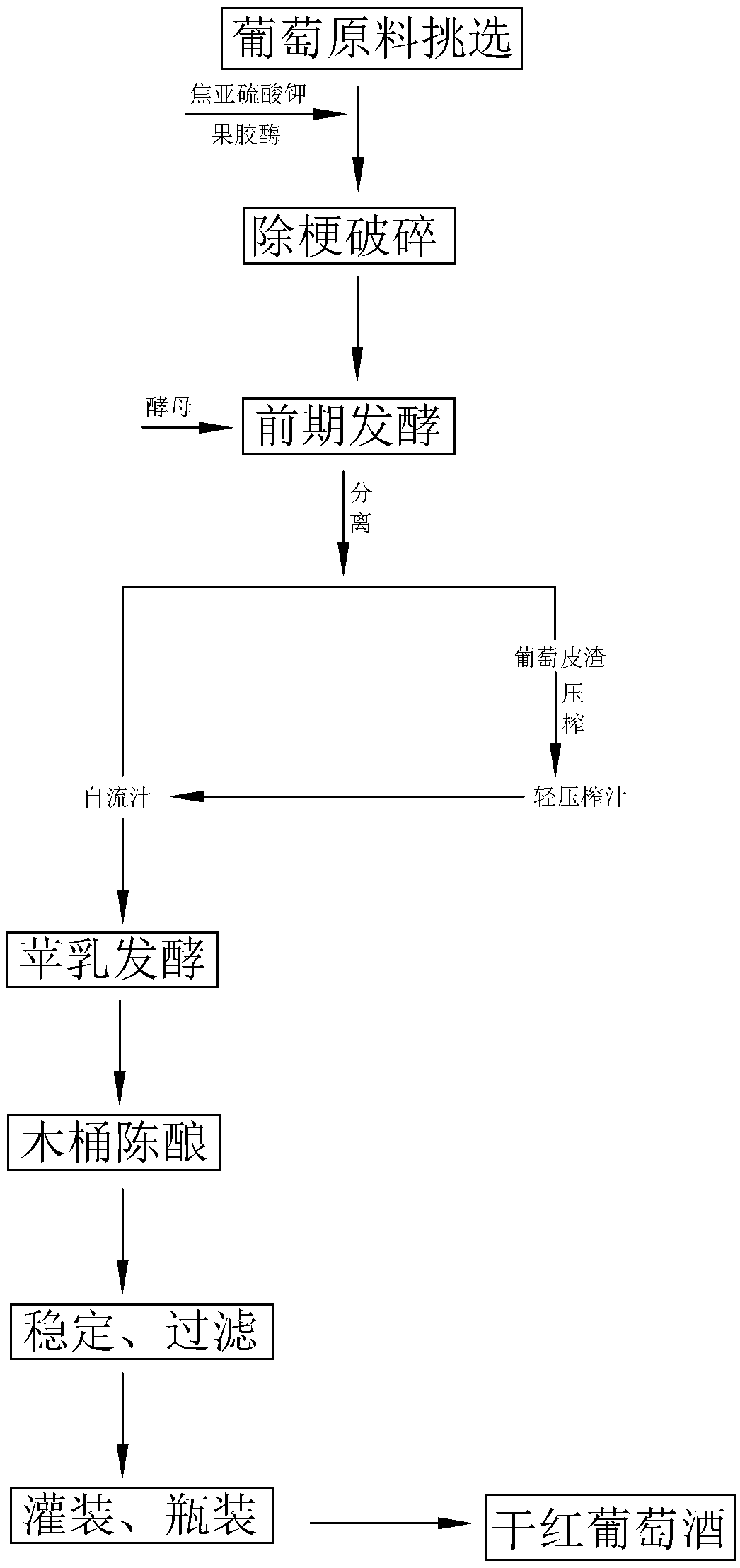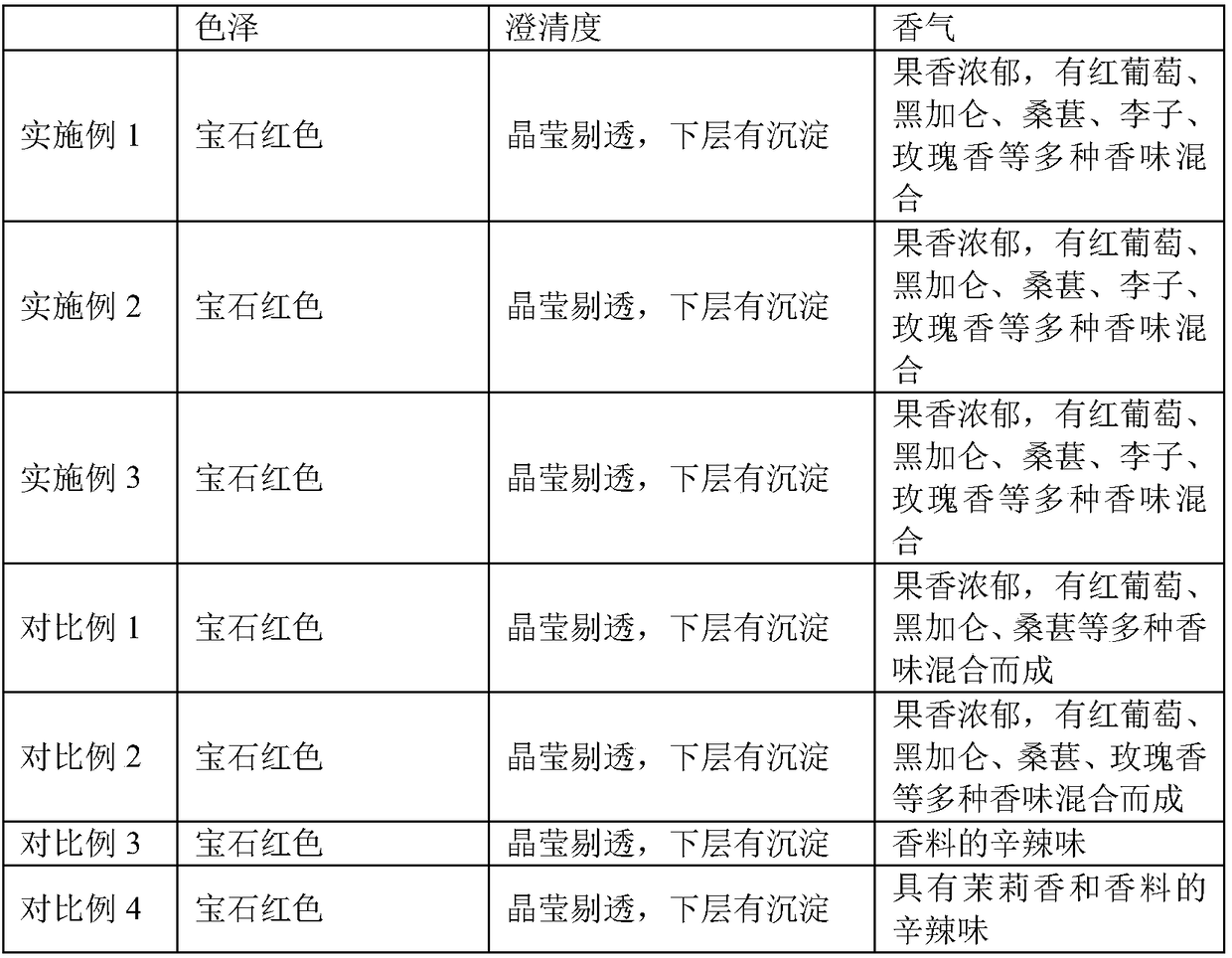Claret making process
A dry red wine and grape technology, applied in the preparation of wine, alcoholic beverages, microorganisms, etc., can solve the problems of poor wine quality and achieve the effect of fruity aroma
- Summary
- Abstract
- Description
- Claims
- Application Information
AI Technical Summary
Problems solved by technology
Method used
Image
Examples
Embodiment 1
[0031] A dry red wine brewing process, such as figure 1 shown, including the following steps:
[0032] S1. Grape sorting: The initial grapes are sorted and selected through three processes of field primary selection, sorting and picking, and manual selection in the factory, and the moldy, green, and diseased grapes are removed to ensure that each grape is Fully mature and intact, enter the next process. The grapes entering the next process are the grape raw materials. The sugar content of the grape raw materials is 230-250g / L, and the acid content is 6.5-8.5g / L.
[0033] S2. Destemming and crushing: Destemming and breaking grape raw materials to obtain raw materials. Specifically, breaking the skins and destemming of raw grapes can be achieved by destemming and crushing machines. Potassium sulfite 50g / t and pectinase 30g / t.
[0034] S3. Pre-fermentation: The pre-fermentation is realized through a fermenter. Taking 1 ton of grapes as a reference, 200g / t of yeast is added to t...
Embodiment 2
[0045] A kind of dry red wine brewing process, carries out according to operation step in embodiment 1, difference is,
[0046] In step S2 destemming and crushing, taking 1t of grapes as a reference, add 40g / t of potassium metabisulfite and 10g / t of pectinase;
[0047]S3. Pre-fermentation: The pre-fermentation is realized through a fermenter. Taking 1 ton of grapes as a reference, 300g / t of yeast is added to the raw material obtained after destemming and crushing for fermentation. The fermentation temperature is 28°C, and the fermentation time is 12 days. During the process, the volatile acid is controlled to 0.5g / L, and when the specific gravity of the fermentation liquid drops to 0.995, the fermentation is terminated;
[0048] Among them, the yeast added includes Saccharomyces cerevisiae and non-Saccharomyces cerevisiae, and the non-Saccharomyces cerevisiae is Klerck's yeast citrate; the specific operation is: initially add 70 g / t of non-Saccharomyces cerevisiae, and add 230...
Embodiment 3
[0057] A kind of dry red wine brewing process, carries out according to operation step in embodiment 1, difference is,
[0058] In step S2 destemming and crushing, taking 1t of grapes as a reference, add potassium metabisulfite 60g / t and pectinase 30g / t;
[0059] S3. Pre-fermentation: The pre-fermentation is realized through a fermenter. Taking 1 ton of grapes as a reference, 250g / t of yeast is added to the raw material obtained after destemming and crushing for fermentation. The fermentation temperature is 30°C, and the fermentation time is 15 days. During the process, the volatile acid is controlled to be 0.3g / L, and when the specific gravity of the fermentation broth drops to 0.996, the fermentation is terminated;
[0060] Among them, the yeast added includes Saccharomyces cerevisiae and non-Saccharomyces cerevisiae, and the non-Saccharomyces cerevisiae is Klerck's yeast citrate; the specific operation is: initially add 45 g / t of non-Saccharomyces cerevisiae, and add 215 g / ...
PUM
 Login to View More
Login to View More Abstract
Description
Claims
Application Information
 Login to View More
Login to View More - R&D
- Intellectual Property
- Life Sciences
- Materials
- Tech Scout
- Unparalleled Data Quality
- Higher Quality Content
- 60% Fewer Hallucinations
Browse by: Latest US Patents, China's latest patents, Technical Efficacy Thesaurus, Application Domain, Technology Topic, Popular Technical Reports.
© 2025 PatSnap. All rights reserved.Legal|Privacy policy|Modern Slavery Act Transparency Statement|Sitemap|About US| Contact US: help@patsnap.com



